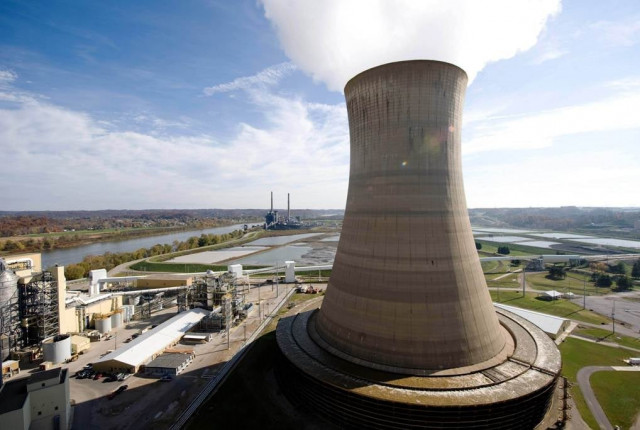Coal to continue to be the dominant power source
Those who believe coal technology is coming to an end are mistaken

PHOTO: AFP
These projects include some big coal and gas-fired power stations. But with the positive step, we find ourselves encompassed by numerous challenges, which were expected.
Those who do not want the nation tackle the challenges of energy and water supplies as well as terrorism, are all out against the coal-fired electricity. The ambiguity they are creating in the minds of public is that coal pollution kills people and that coal plants are shutting down worldwide.
At present, coal energy has a meagre share of 0.04% in Pakistan’s energy mix against 41% worldwide. But is it safe to invest in coal, especially after hearing every second person terming coal dangerous and a pollutant?
Coal consumption
Many people would be stunned to know that 1,200 coal-fired plants were proposed worldwide in 2012 with a cumulative generation capacity of 1,401,268 megawatts.
Of course, many of these projects would not be completed, but it presents a good picture that shows that coal dominance will continue for years to come. About 70% of these projects are based in China and India, the traditional coal-based economies.
The IEA Clean Coal Centre’s 2015 report also concludes that traditional coal-based countries like China, India, Indonesia, the Philippines and South Korea will continue pursuing coal.
Global coal consumption grew from 4,762 million tons in 2000 to 7,697 million tons in 2012, a 60% growth or 4% average growth per year.
IEA also claims that global coal consumption will reach 9 billion tons in 2019. These facts negate the claims of those who think that coal is vanishing in the near future.
China’s policies
China, by far, is the world’s leading producer and consumer of coal. The country burns more coal than any other nation, both as a proportion of energy supply (70%) and in absolute terms (3 billion tons in 2008, more than twice the US). This is the reason that it has to keep a particular eye on meeting environmental standards.
In a bid to improve the situation, China is backing a wide range of efforts to curb the rapid growth in coal consumption and look for cleaner ways to burn fuel. These policies include shutting down old inefficient coal plants located in major cities. These plants have already completed their lives and are bound to close.
These plants had old pollution control technologies that are nowhere as stellar as the existing ones. China’s long-term policy includes building state-of-the-art technology (Supercritical and Ultra-supercritical) based coal plants.
Critics just look at the number of plants that are retiring without considering the bigger picture.
India’s policies
India has similar policies, having 68% coal in its energy mix, and is proposing more plants employing both traditional subcritical technology and efficient supercritical technology.
Ultra Mega Power Projects (UMPP) are a series of ambitious coal power stations planned by India, each with a capacity of 4,000MW or above.
India has a very experienced coal fleet and its coal plants have been playing a greater role in developing national economy as well as local communities.
The country is making sure that coal plants employ all the latest pollution control technologies. Ash disposal systems are getting better and majority of coal ash is utilised in cement industries.
Pollution control
Recently, former Balochistan Assembly speaker Aslam Bhootani termed Hubco’s proposed coal project hazardous without citing any concrete facts and figures. I think it would be better if politicians leave these matters to engineers and experts rather than making baseless allegations.
Latest global coal technologies employ supercritical boilers which cut down emissions and save fuel. Electro Static Precipitators (ESPs) are installed to control particulate matter emissions. Low NOx burners for burning of pulverised coal are specially designed to reduce NOx (Nitrogen Oxides) emission in comparison with other burners.
Flue gas desulphurisation (FGD) reduces SOx (Sulphur Oxides) content. Dust Suppression Systems are provided at the point of dust generation eg ash silo, ESP, bunker silos, etc. Hubco is planning to employ all these technologies and will spend around 10% of project cost on these pollution control technologies.
A detailed Environment and Social Impact Assessment (ESIA) has been carried out at the site. The site will follow all NEQS (National Environment Quality Standards) and IFC (International Finance Corporation) standards.
To conclude, those who claim that coal-fired technology is ending in the near future are living in a fool’s paradise. EIA’s 2015 energy outlook report concludes that coal will continue to be the dominant power source till 2040 despite shift in policies of US and European countries.
The writer is a NUST graduate with profound interest in sports, current affairs and writing
Published in The Express Tribune, June 1st, 2015.
Like Business on Facebook, follow @TribuneBiz on Twitter to stay informed and join in the conversation.



















COMMENTS
Comments are moderated and generally will be posted if they are on-topic and not abusive.
For more information, please see our Comments FAQ